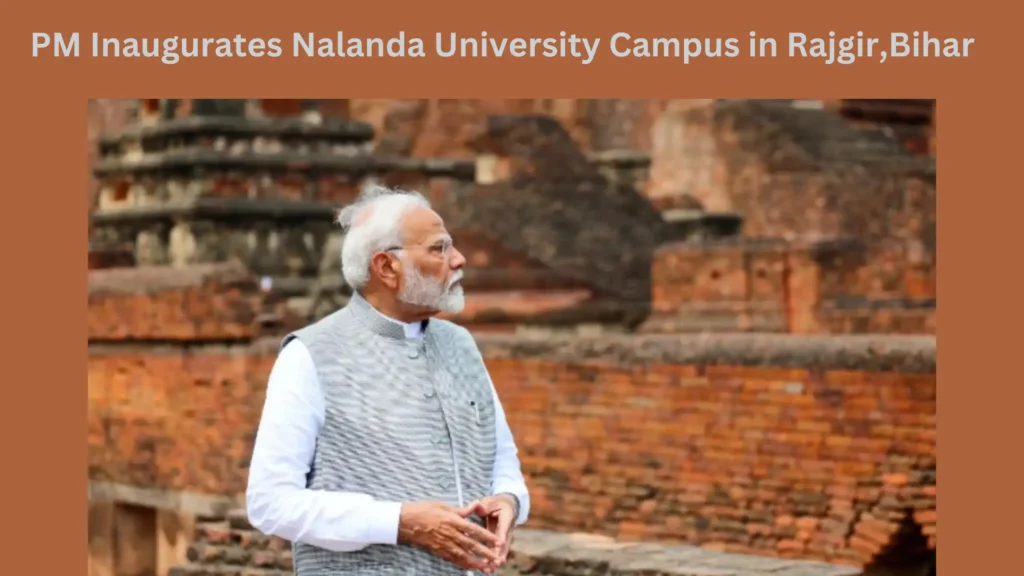On June 19, Prime Minister Narendra Modi dedicated the recently constructed Nalanda University Campus in Rajgir, Bihar. This university is situated close to Nalanda Mahavihara, an ancient seat of learning with a long and illustrious history. The Prime Minister declared his desire for India to become the leading knowledge hub of the world again, with a cutting-edge, research-focused higher education system.

Here is the list of major facilities at the campus:
- The campus consists of two academic blocks with forty classrooms that can accommodate about 1900 people in total.
- It features two auditoriums, each with 300 seats.
- There is a student hostel there that can accommodate about 550 people.
- It also features a number of other amenities, such as the Faculty Club, Sports Complex, International Center, and Amphitheater, which can hold up to 2000 people.
- The campus is a green, “Net Zero” campus.
- With 100 acres of water bodies, a solar plant, a drinking and household water treatment facility, a water recycling plant for reusing wastewater, and many other environmentally friendly amenities, it is self-sufficient.
Here are ten things about Nalanda you may like to know.
1. Nalanda Mahavihara
”An ancient Buddhist monastery and school located in Magadha (modern-day Bihar) was called the Nalanda Mahavihara. In addition to studying and researching Buddhist philosophy, it served as a thriving forum for discussion on a wide range of other topics.”
2. The ‘zero’ connection
“It is believed that Aryabhata, who is credited with creating zero, served as Nalanda’s kulapati (head) in the sixth century CE.”
3. Longevity
”The institution was a place of learning from the fifth century CE to the thirteenth century CE. This means that it was the seat of knowledge in India for 800 years.”
4. Teaching of a multitude of subjects
”The primary teaching of Nalanda was Buddhist philosophy. However, students and teachers engaged in the discussion of various subjects. They include logic, grammar, astronomy, medicine, and mathematics.”
5. The Xuanzang connection
”Monk Xuanzang is a Buddhist from China. It is thought that he discovered Nalanda while traveling the Silk Road to India. He spent several years there, instructing and studying from this center of knowledge. Upon his return to China, he carried numerous Buddhist scriptures. He propagated Buddhist ideas throughout China by translating them into Mandarin.”
6. Dharmaganj
“There was an enormous library at Nalanda University that contained palm manuscripts. The Dharmaganj library held the approximately nine million manuscripts. It was made up of three structures called Ratnadadhi, Ratnaranjak, and Ratnasagar. There were up to nine stories in one of the buildings. Up until Bakhityar Khiliji destroyed the university and set fire to the library, the libraries are supposed to have flourished throughout the twelfth century.”
7. Discovery
“After the destruction of the University, it underwent a decline and was forgotten for six centuries. Its ruins were discovered by Francis Buchanan in 1812 and identified as the esteemed Nalanda University by Alexandar Cunningham in 1861. The site was excavated and systematically consolidated by the Archaeological Survey of India from 1915 to 1937 and from 1974 to 1982.”
8. Nalanda University Bill
“On August 12, 2010, the Nalanda University Bill, 2010, which aimed to resurrect the historic University of Nalanda, was presented in the Rajya Sabha, following APJ Abdul Kalam’s vision. On August 21, 2010, the Rajya Sabha approved it, and on August 26, 2010, the Lok Sabha did as well. On September 21, 2010, the bill was ratified by the president and became law. On November 25, 2010, the statute came into effect and the University was formally founded. “
9. World Heritage Site
“On January 9, 2009, the Nalanda site was included to the Tentative List of World Heritage. The “Excavated Remains of Nalanda Mahavihara” nomination report was subsequently created by the Archaeological Survey of India and submitted to the World Heritage Committee in January 2015. UNESCO inducted Nalanda as a World Heritage Site on July 15, 2016.”
10. Current situation
Launched by Prime Minister Narendra Modi, the new Nalanda University campus. Its 100 acres of water bodies, solar plant, water treatment plant, and water recycling plant are among the amenities that support its claim to be a “Net Zero” green campus. The university features two academic buildings with 1900 seats each, split between 40 classes. Its outstanding facilities include an amphitheater that can accommodate up to 2000 people, two 300-seat auditoriums, and a hostel that can house 550 students.



